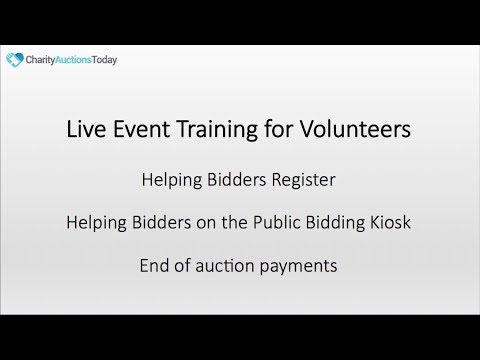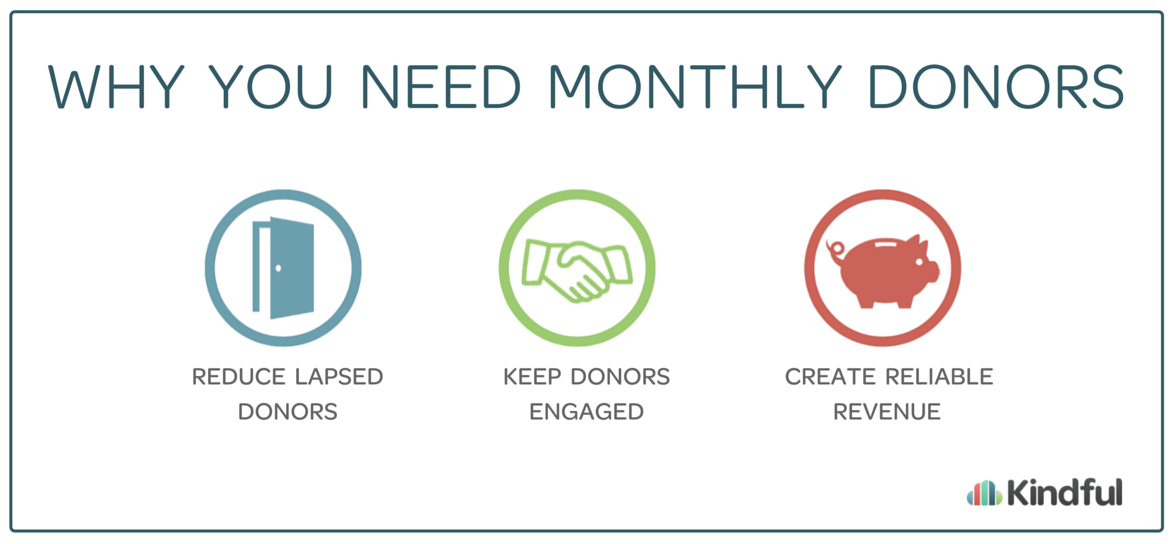Keep Volunteers Happy through Training and Engagement
It’s important to keep your nonprofit volunteers happy and engaged. Finding and securing volunteers interested and ready to commit time to your nonprofit can be overwhelming. That’s why, once a volunteer signs on, it’s vital to keep him interested, excited, and motivated about this new volunteer role. Keeping volunteers happy is key to your success.
Like starting a new job, a volunteer is most intent and focused on the first day of volunteering. This is the day, if not before, to make a good impression and show the volunteer what they’ll be doing and why it’s important to the goals and mission of the organization.
Happy Volunteers Fuel Sustainable Impact
You’ve learned how to keep your volunteers motivated and appreciated. Now put that strength to work — launch your auction and give your team something meaningful to rally behind.
Launch Your Volunteer-Powered AuctionKeeping Volunteers Happy: A Guide to Retention
Communication
Creating open two-way communication is vital for a successful volunteer engagement with your nonprofit. Volunteers give their time because of an interest in the work of the nonprofit and because they want to feel helpful and needed, and that their involvement makes a difference. It’s important to build on these needs by showing appreciation of their time and sharing information about the organization – the what, why, and results of the nonprofit’s work and mission.
Planning a Volunteer Program
Prior to training volunteers, it’s important to identify and outline what the volunteer program is, the role of volunteers, and how you’ll manage their work and engagement with the organization. Once this is defined and documented, a volunteer handbook can be developed. This handbook will support volunteers through the process of joining the organization, delivering on the volunteer role, and possibly helping to lead and train other volunteers who join.
Training Volunteers
The training of volunteers needs to be customized. This means it should be targeted to individual volunteer types – full-time or part-time and each functional role volunteers may fill – which can include back office support, being out in the field or fundraising tasks, and more. There is also a foundation part of volunteer training that is standardized for all volunteers.
This includes two sections:
Basic information and knowledge of nonprofits, such as: What is a nonprofit? How does it function? What is the role of fundraising? And lastly, what are the ethical responsibilities of a nonprofit, and what is expected while representing one?
A general overview of your nonprofit. This is around the mission and values of the organization, its program needs, goals, and expected outcomes.
You can find more information and an outline on Developing Your Volunteer Program from Idealist.
Ruth Kustoff is principal and learning strategist of Knowledge Advantage. She supports nonprofits and corporate clients alike in developing and improving employee engagement, productivity, and performance success through custom learning solutions and better information sharing across the organization.
Frequently Asked Questions
What truly keeps volunteers happy and coming back?
Clarity, connection, and appreciation. Volunteers thrive when they understand their role, feel part of a welcoming community, see their impact, and are thanked specifically and often.
How do we set clear roles and expectations from day one?
- Share a one-page role description with objectives and time commitment.
- Define success (3–5 outcomes) and a primary point of contact.
- Explain policies, boundaries, and how to ask for help.
How can we tailor the experience to different volunteer motivations?
- Mission-first: show direct impact stories and outcomes.
- Social: provide team shifts and community spaces.
- Skill-building: offer training, certificates, and references.
- Flexible helpers: short shifts, clear micro-tasks, easy sign-up.
What should a simple volunteer onboarding include?
- Welcome message, mission snapshot, and role overview.
- Mini orientation: who we serve, safety basics, and escalation contact.
- First assignment with clear steps, schedule, and materials.
How do we train volunteers without overwhelming them?
Use short, task-based modules (10–15 minutes), shadowing on first shift, and one-page quick guides. Focus on the first job to be done and provide a cheat sheet they can keep.
What scheduling practices make volunteers happiest?
- Self-serve sign-ups and easy swap options.
- Shorter, predictable shifts (60–120 minutes) when possible.
- Automatic reminders 24–48 hours before the shift.
How often should we communicate with volunteers between shifts?
Send a concise monthly update, a pre-shift reminder with essentials, and a short post-shift thank-you with a one-line impact metric. Keep messages skimmable and actionable.
What volunteer recognition actually feels meaningful (not perfunctory)?
- Name-specific thanks tied to outcomes (“Your data entry reached 143 families”).
- Spotlight stories in newsletters and social posts (with permission).
- Small surprises: handwritten notes, coffee cards, milestone badges.
How do we create a healthy feedback loop with volunteers?
- End each shift with a 30-second check-in (“What went well? Any blockers?”).
- Quarterly mini-survey (3–5 questions) on satisfaction and ideas.
- Close the loop: reply with what changed because of their input.
How should we handle conflicts or underperformance? (General information)
Use private, kind conversations anchored to role expectations; offer coaching or a better-fit assignment. Document agreements and follow up. General information, not legal advice.
What are practical ways to prevent volunteer burnout?
- Cap weekly hours and rotate demanding roles.
- Encourage breaks and allow “seasonal” volunteering.
- Normalize saying “no” and provide easy off-ramps when needed.
How do we make volunteering inclusive and accessible? (General information)
- Offer roles with varied physical, time, and skill requirements.
- Provide clear directions, large-print signage, and captioned videos.
- Invite input on accommodations and act promptly.
General information, not legal advice.
What safety practices should we put in place for volunteers? (General information)
- Brief on-site safety: exits, first aid, incident reporting.
- Role-appropriate training and required protective gear.
- Clear boundaries for client interactions and data handling.
General information, not legal advice.
Should we reimburse volunteer expenses or offer perks? (General information)
Create a simple policy for pre-approved expenses (e.g., supplies, mileage) and outline any perks (snacks, shirts, parking). Communicate the process clearly. General information, not financial or legal advice.
How do we show volunteers the difference they’re making?
- Share quick metrics after shifts (“82 kits packed today!”).
- Send monthly impact snapshots with one short story.
- Invite volunteers to see programs in action when appropriate.
How can we create growth and leadership paths for volunteers?
Offer tiered roles (helper → lead → trainer), micro-credentials, and references. Host brief “train-the-trainer” sessions and let experienced volunteers mentor newcomers.
What’s a positive way to re-engage lapsed volunteers?
Send a warm update with a specific, low-lift invitation (e.g., a 60-minute shift or a one-time project), acknowledge their past impact, and offer flexible options.
Should we do exit surveys when volunteers pause or leave? (General information)
Yes—ask 3–5 questions on satisfaction, barriers, and suggestions. Thank them, and summarize learnings for staff. Handle responses per your privacy practices. General information only.
Which metrics indicate volunteer happiness and program health?
- Retention rate and average shifts per volunteer.
- Fill rate of posted shifts and last-minute cancellations.
- Post-shift satisfaction and referral rate (inviting a friend).
Do you have a quick event-day checklist for happy volunteers?
- Clear signage, fast check-in, name badges, and a friendly welcome.
- Quick huddle: roles, timeline, safety, and escalation contact.
- Provide water/snacks, scheduled breaks, and a thank-you sendoff.
- Post-event: share results within 48 hours and invite the next step.
💡 Try this in ChatGPT
- Summarize the article "Keeping Volunteers Happy" from https://ghost.charityauctionstoday.com/p/keeping-volunteers-happy/ in 3 bullet points for a board update.
- Turn the article "Keeping Volunteers Happy" (https://ghost.charityauctionstoday.com/p/keeping-volunteers-happy/) into a 60-second talking script with one example and one CTA.
- Extract 5 SEO keywords and 3 internal link ideas from "Keeping Volunteers Happy": https://ghost.charityauctionstoday.com/p/keeping-volunteers-happy/.
- Create 3 tweet ideas and a LinkedIn post that expand on this Volunteers topic using the article at https://ghost.charityauctionstoday.com/p/keeping-volunteers-happy/.
Tip: Paste the whole prompt (with the URL) so the AI can fetch context.
Tom Kelly
Tom Kelly, TEDx speaker and CEO of CharityAuctions.com, helps nonprofits raise millions through auctions and AI. He hosts The Million Dollar Nonprofit podcast and inspires leaders to live their legacy, not just leave it.
Table of contents
Create Your Auction
Raise 40% more with smart bidding tools






